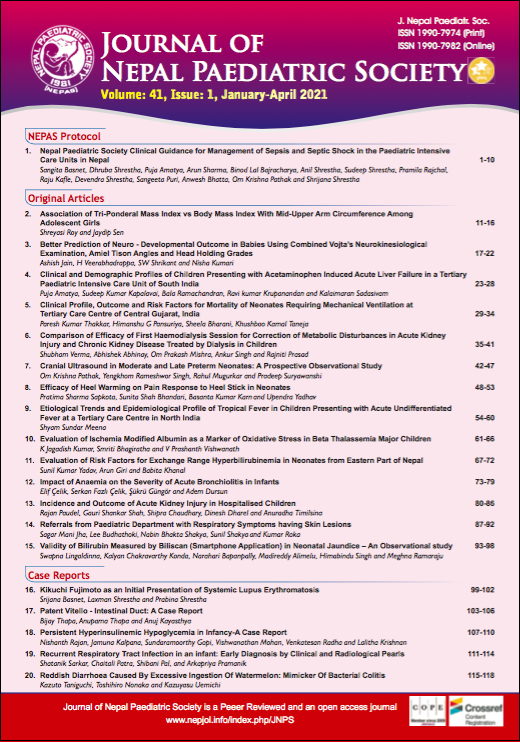Etiological Trends and Epidemiological Profile of Tropical Fever in Children Presenting with Acute Undifferentiated Fever at a Tertiary Care Centre in North India
DOI:
https://doi.org/10.3126/jnps.v41i1.29595Keywords:
Acute undifferentiated fever (AUF), Dengue, Malaria, Scrub Typhus, Tropical FeversAbstract
Introduction: The objective of this study was to determine the etiology of acute undifferentiated fevers (AUF) in hospitalised children with in a tertiary care centre in North India. The various causes of acute undifferentiated fevers included dengue, malaria, scrub typhus, enteric fever, leptospirosis and Chikungunya. The clinical spectrum and therapeutic outcome of these cases was also studied.
Methods: This retrospective study was conducted over a period of 6 months from June 2019 to December 2019. The clinical information of 126 children who tested positive for any of the causes of AUF namely dengue, malaria, scrub typhus, enteric fever, chikungunya and leptospirosis was obtained from the Paediatrics Department. The information was recorded in a predesigned proforma. Various tests performed for the diagnosis of these illnesses were noted. They included dengue NS1 antigen ELISA and IgM ELISA, peripheral blood smear (PBS) for malarial parasite and rapid malarial antigen detection test (RMAT), scrub typhus IgM ELISA, leptospira IgM ELISA, and Chikungunya IgM ELISA.
Results: The diagnosis of AUF were dengue (55.5%; 70/126), malaria (19%; 24/126) and scrub typhus (19%; 24/126), enteric fever (4.7%;6/126) and Chikungunya (1.5%; 2/126). The most common presenting symptom was fever or pyrexia followed by myalgia, generalised aches and pains in the body and vomiting. Commonly observed complications included thrombocytopenia, hepatitis and shock.
Conclusions: Dengue, malaria and scrub typhus are the major causes of AUF in the hospitalised children with dengue being the most prevalent infection. The study further emphasises the need to develop a systematic approach to the diagnosis of AUFs. This should be using a combination of clinical, epidemiological and laboratory parameters, which will be very useful for developing a relevant action plan for treatment and prevention of such fevers in any hospital setup.
Downloads
Downloads
Published
How to Cite
Issue
Section
License
Authors who publish with this journal agree to the following terms:
Authors retain copyright and grant the journal right of first publication with the work simultaneously licensed under a Creative Commons Attribution License that allows others to share the work with an acknowledgement of the work's authorship and initial publication in this journal.
Authors are able to enter into separate, additional contractual arrangements for the non-exclusive distribution of the journal's published version of the work (e.g., post it to an institutional repository or publish it in a book), with an acknowledgement of its initial publication in this journal.
Authors are permitted and encouraged to post their work online (e.g., in institutional repositories or on their website) prior to and during the submission process, as it can lead to productive exchanges, as well as earlier and greater citation of published work (See The Effect of Open Access).



